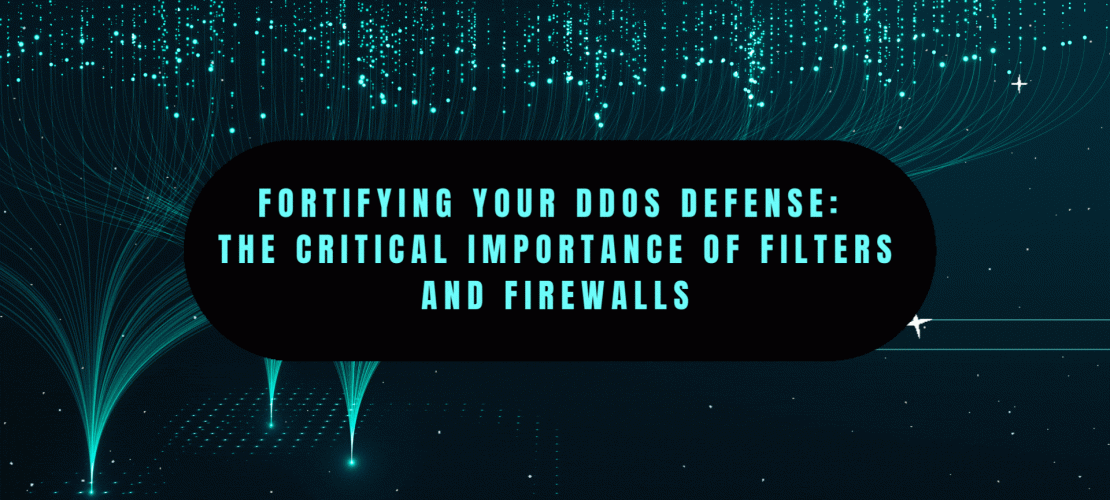As cyber attacks continue to increase in sophistication and frequency, it’s becoming more and more important to fortify your network against threats. Distributed Denial of Service (DDoS) attacks are one of the most common types of attacks and can be devastating for businesses of all sizes. In this blog, we’ll explore the critical importance of filters and firewalls in fortifying your DDoS defense.
Understanding DDoS Attacks
Before we dive into filters and firewalls, let’s briefly review what a DDoS attack is and how it works. In a DDoS attack, a large number of compromised devices (known as a botnet) flood a targeted server or network with traffic, overwhelming it and causing it to crash or become unavailable to legitimate users. This can have a serious impact on a business’s operations, leading to lost revenue, damaged reputation, and even legal consequences.
There are various types of DDoS attacks, including volumetric attacks (which flood the target with a large volume of traffic), protocol attacks (which exploit weaknesses in specific protocols), and application-layer attacks (which target vulnerabilities in web applications).
The Role of Filters and Firewalls
Filters and firewalls are critical components of DDoS defense, as they can help block unwanted traffic and protect against specific types of attacks.
Filters
Filters are used to block traffic based on specific criteria, such as the source IP address, the type of traffic (e.g., HTTP or FTP), or the destination port. They can be implemented at different levels of the network stack, including the network layer (Layer 3) and the transport layer (Layer 4).
At the network layer, filters can be used to block traffic based on the source IP address. This is particularly effective against spoofed attacks, where the attacker falsifies the source IP address to make it appear as though the traffic is coming from a legitimate source. By blocking traffic from known malicious IPs, filters can help prevent these types of attacks.
At the transport layer, filters can be used to block traffic based on the destination port. This can help protect against protocol-specific attacks, where the attacker targets a specific protocol (such as DNS or SMTP) to exploit vulnerabilities and overwhelm the target.
Firewalls
Firewalls are similar to filters in that they can block traffic based on specific criteria. However, firewalls are more sophisticated and can also inspect the contents of traffic to identify and block malicious payloads.
Stateful firewalls are the most common type of firewall used in DDoS defense. They maintain a state table of all active connections, allowing them to identify and block traffic that doesn’t match a known state (such as SYN packets that don’t have a corresponding ACK packet).
Application-layer firewalls are another type of firewall that can be used to protect against application-layer attacks. These firewalls inspect the contents of traffic to identify and block malicious payloads, such as SQL injection or cross-site scripting (XSS) attacks.
Best Practices for Filters and Firewalls
While filters and firewalls are critical components of DDoS defense, they are not a one-size-fits-all solution. To effectively protect your network against DDoS attacks, you need to implement a multi-layered defense strategy that includes a combination of filters, firewalls, and other security measures.
Here are some best practices for implementing filters and firewalls:
- Use filters and firewalls at multiple layers of the network stack to provide comprehensive protection against different types of attacks.
- Regularly update your filters and firewalls to ensure that they are protecting against the latest threats.
- Implement rate limiting to prevent the overwhelming of the network with too many requests.
- Configure your firewalls to block all traffic that does not meet specific criteria, such as those not originating from an authorized IP.
- Use intrusion detection and prevention systems (IDPS) An IDPS is designed to detect and prevent unauthorized access or attacks on your network. This system can be configured to alert you when suspicious activity is detected and block the offending IP address. IDPS can also monitor your system for unusual patterns and help identify new threats.
- Keep your firewall and filter rules up to date As new threats emerge, it is important to update your firewall and filter rules to stay protected. This means regularly reviewing and updating your rules to ensure that they are still relevant and effective. Failure to update your rules can leave your network vulnerable to new threats and attack methods.
- Monitor your network traffic To stay ahead of attacks, you need to constantly monitor your network traffic. This can help you identify potential threats before they become major issues. A network traffic monitoring tool can help you monitor traffic patterns, identify unusual behavior, and detect potential attacks in real-time.
Conclusion
DDoS attacks continue to be a significant threat to businesses of all sizes. By implementing robust firewall and filter solutions, you can significantly reduce the risk of a successful DDoS attack. It is important to implement a multi-layered defense strategy that includes firewalls, filters, and IDPS. Regularly updating your firewall and filter rules and monitoring your network traffic can also help you stay ahead of potential attacks. With the right tools and practices in place, you can fortify your DDoS defense and protect your network from harm.




